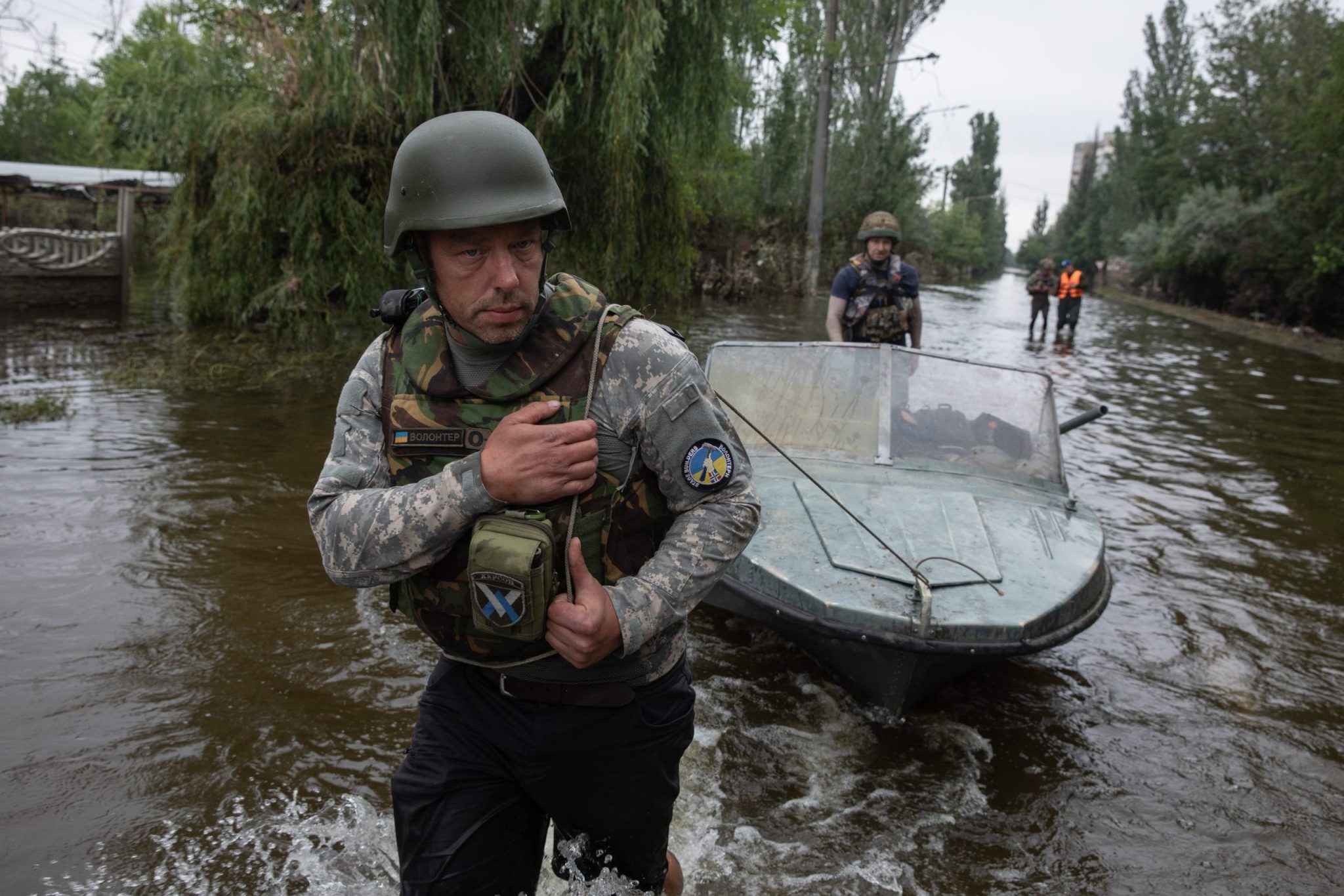Overview
In the early hours of June 6, an explosion collapsed the Kakhovka dam, releasing a torrent of water across the Ukrainian countryside and igniting a blame game across social media. Evidence collected by the New York Times indicates that Russia was responsible for the blast, but immediately after the dam gave way, Kremlin-linked accounts launched one of their highest-volume messaging campaigns of the war to convince the world that Ukraine was responsible. The volume of Russian propaganda about the Kakhovka dam outpaced information drives around other wartime flashpoints, including messaging on the Nord Stream bombings and the Bucha massacre. However, the Kremlin’s accusations that Ukraine bombed the dam, that the West helped, and that independent reporters are spreading disinformation to frame Russia for the destruction have failed to generate the level of engagement that other information campaigns have produced. This high volume of content and relatively low level of engagement showcases both the capacity and limitations of Russia’s propaganda machine.
By the Numbers
Russia’s propaganda push around the Kakhovka dam’s collapse marked one of the Kremlin’s most aggressive overt messaging campaigns of the war. In the week after the dam was destroyed, Russian diplomatic and media accounts tweeted “Kakhovka” or “dam” more than 1,300 times. Those tweets earned nearly 200,000 retweets and more than 480,000 likes. To contextualize the scale and reach of Russia’s messaging around the Kakhovka dam, we compared Russian state media and diplomatic tweets mentioning the dam explosion to two other flashpoints in the war: the Bucha massacre and Nord Stream pipeline bombing. Comparing a week of data after each respective event, Kremlin-linked accounts sent 9% more tweets about the dam explosion than the Bucha massacre and 30% more tweets about the dam than the Nord Stream bombings. However, the information campaign around the Kakhovka dam generated less engagement than the previous incidents. Dam-related posts earned 37% fewer retweets than Bucha posts and 5% fewer retweets than Nord Stream posts. There was a similar disparity around likes, with dam-related posts generating 18% fewer likes than Bucha posts and 13% fewer likes than Nord Stream tweets. Data also shows that the United States was the third most mentioned country—after Russia itself and Ukraine—in tweets referencing the dam, which once again highlights how blaming the United States is central to almost all the Kremlin’s information campaigns.
Russia’s Supposedly Damning Evidence
Immediately following the destruction of the Kakhovka dam, Russian government officials and state-funded media flooded Twitter with claims that Ukraine and the West were responsible for the attack. Kremlin-linked accounts claimed that Kyiv’s alleged attack on the dam proved it was a terrorist state run by Nazis who are unconcerned about citizens, civilian infrastructure, or the environment. Propagandists called Ukraine’s supposed attack an “act of insanity”, a “crime against humanity”, and a “war crime”. They insisted that NATO also bore responsibility, with some accounts amplifying a post that suggested the dam’s collapse was “designed in excruciating detail by CIA/MI6/NATO”.
Russian messengers pushed a range of theories about why Ukraine and its Western partners would destroy the dam. Kremlin spokesman Dmitry Peskov alleged that Ukraine blew up the Kakhovka dam as revenge for its “failed offensive”, while Russia’s Minister of Defense Sergei Shoigu said it was meant to block Russia’s own offensive activities. Others speculated that Ukraine was trying to set up an amphibious assault, to stall the conflict and regroup its forces, or to target the Zaporizhzhia nuclear power plant, which depends on water from the dam. Finally, state media said that Ukraine launched the attack to cut off Crimea’s water supply, with Sputnik host George Galloway retweeting a post that asserted that George Soros had funded Ukraine’s war effort and had previously discussed using Crimea’s water supply as a bargaining chip.
As some Russia-affiliated accounts speculated about Ukraine’s motives, others began putting forward evidence that supposedly proved Ukraine’s culpability. Many accounts pointed to a Washington Post article from 2022, in which Ukrainian Major-General Andriy Kovalchuk discussed potentially flooding the Dnipro river and mentioned a successful test strike on one of the dam’s floodgates. Russia’s Foreign Ministry also posted a timeline detailing Ukrainian military activity around the Kakhovka dam, which dates back to 2014 and alleges that hundreds of Ukrainian missiles were fired around the dam in 2022. Russia insisted that it warned the UN about Ukraine targeting the dam as early as October 2021, and it accused the UN of not taking appropriate action.
Characteristically, Russian state media also aimed to discredit Western reporting on the Kakhovka dam’s collapse. Moscow’s Ambassador to the United States Anatoly Antonov said, “There is a targeted disinformation campaign going on in US media”. A Sputnik piece accused Western press of acting as “stenographers for Zelensky”. Multiple propagandists tried to sow doubt in the credibility of independent reporting on the dam by ridiculing news outlets’ coverage of the Bucha massacre and the Nord Stream bombing. Vassily Nebenzia, Russia’s permanent representative to the UN, warned that Western media “reeks of schizophrenia”. At the same time, Kremlin-funded outlets amplified Western press that supported their narratives, especially Tucker Carlson, who accused Kyiv of the attack during the debut episode of Tucker on Twitter.
In addition to blaming Ukraine and the West for the explosion, Russia tried to bolster its own image by calling for a UN investigation, promising payments to victims of the flood, and boasting about its humanitarian efforts.
Why It Matters
The Kakhovka dam’s destruction caused a humanitarian and environmental disaster while simultaneously altering the course of the war as Ukraine begins its counteroffensive. Russia recognized the gravity of the dam’s collapse and mobilized its propaganda accounts to shape the narrative. In one week, state media and diplomatic accounts posted more than 1,300 tweets about the dam—a messaging drive that outpaced propaganda campaigns around infamous events like the Bucha massacre and the Nord Stream bombing. Russia’s dam-related posts, though, did not generate substantial engagement. This could be because their arguments were less compelling or because of the public’s war fatigue. Either way, it shows that while Russia can control the volume of its propaganda, it cannot make people listen.
The views expressed in GMF publications and commentary are the views of the author alone.






